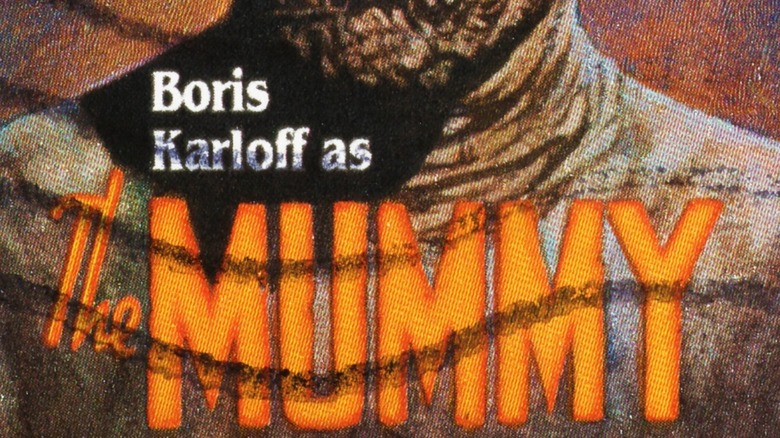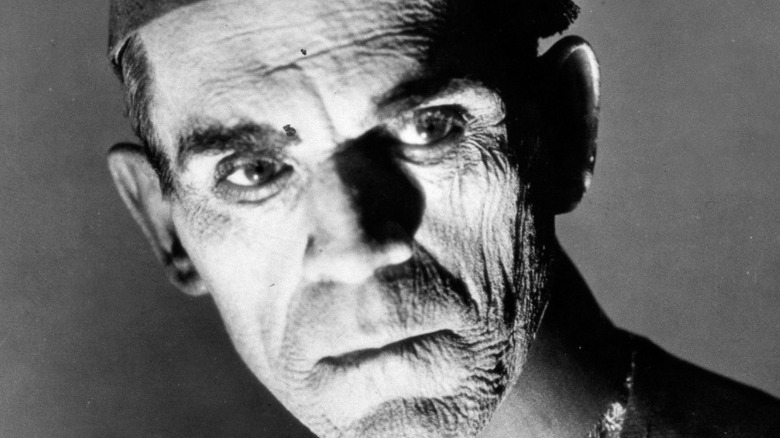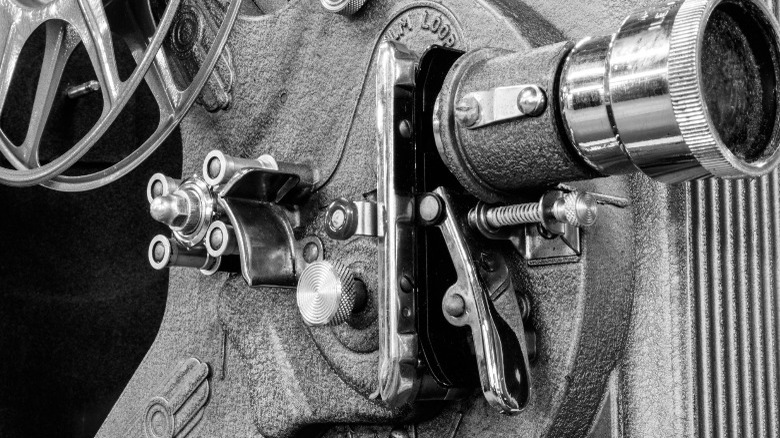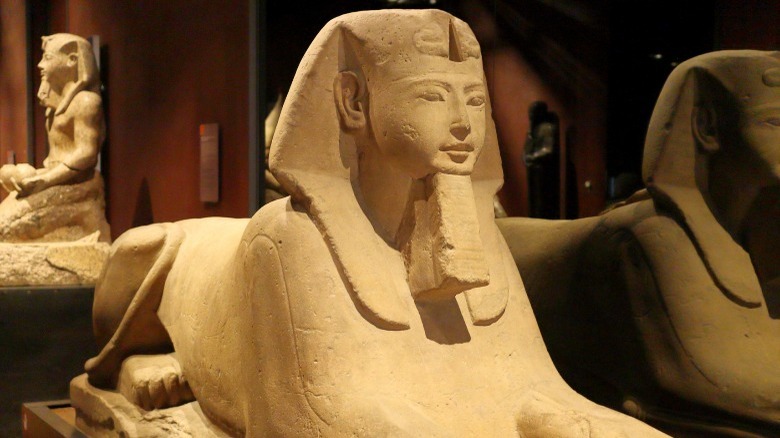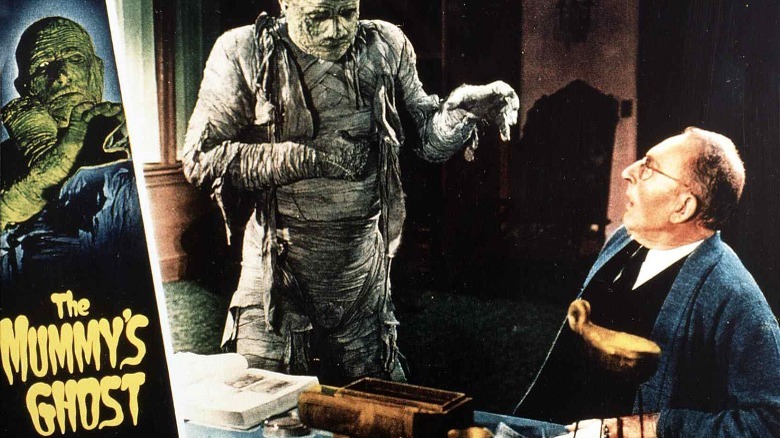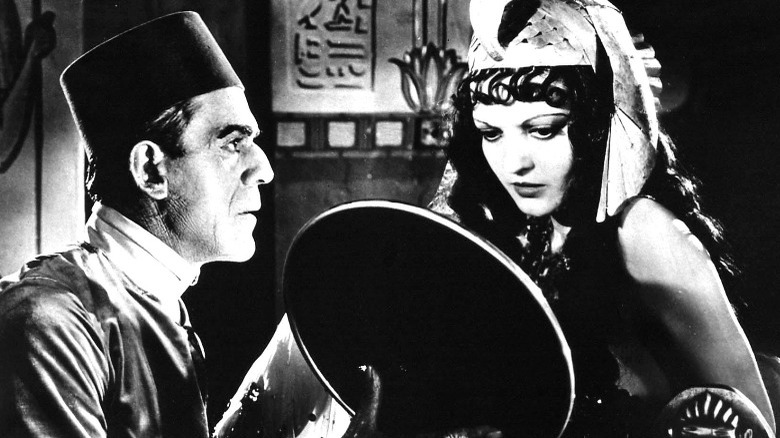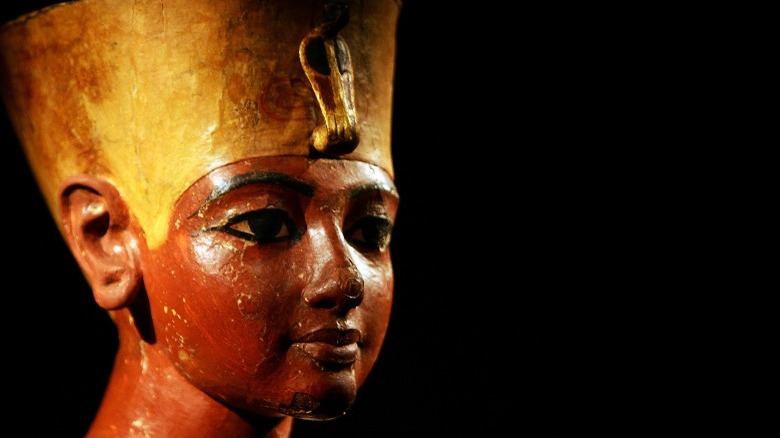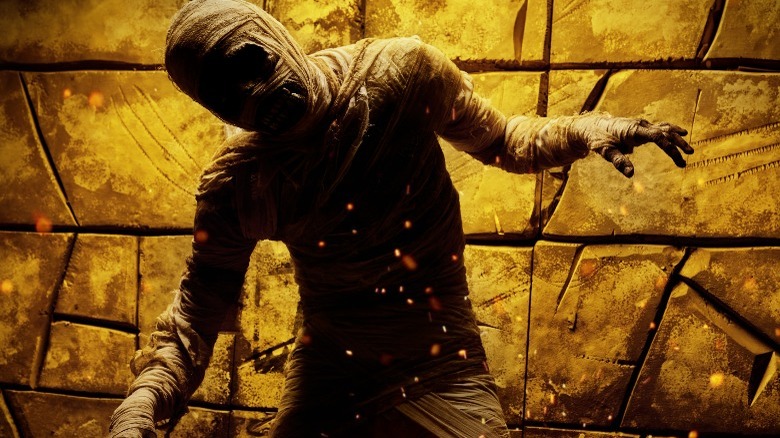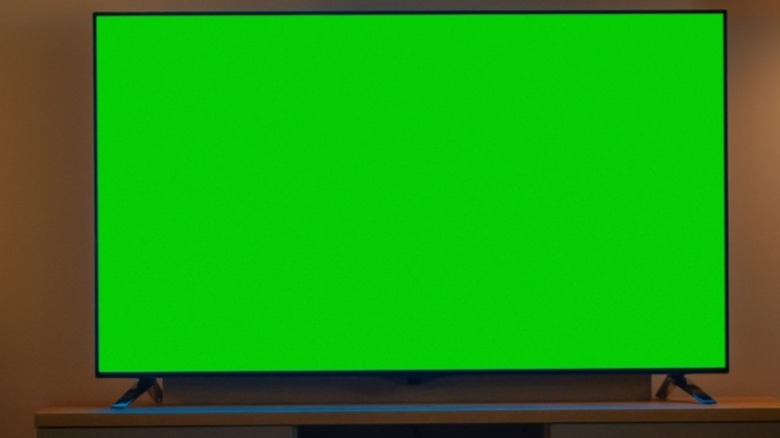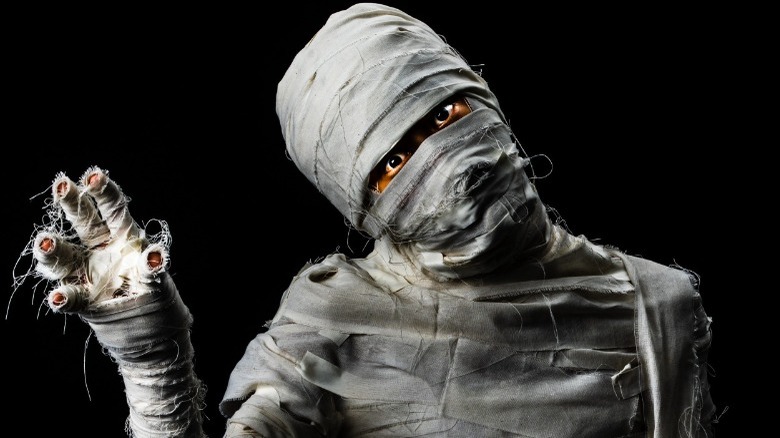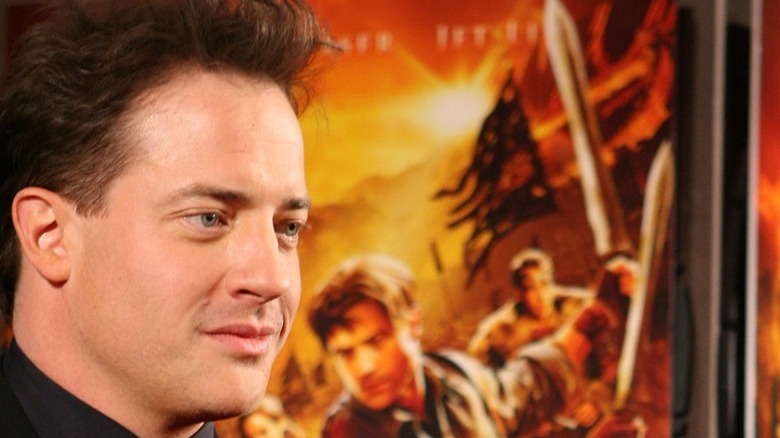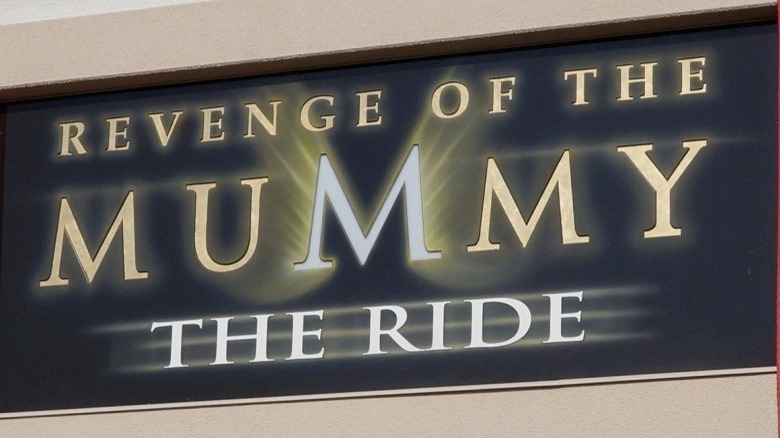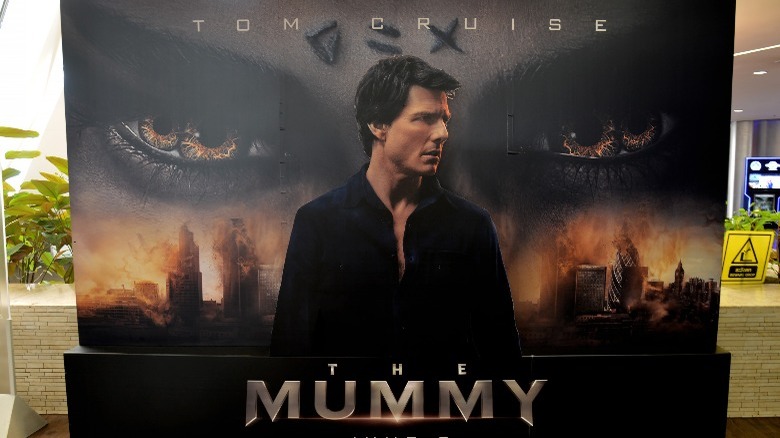The Legacy Of 1932's The Mummy Explained
We may receive a commission on purchases made from links.
The year 2022 marks the 90th anniversary of the 1932 Universal Studios classic "The Mummy." Though not the first film to feature a mummy — that would be 1899's "Robbing Cleopatra's Tomb" — "The Mummy" would become the most influential of the earliest mummy films. Interestingly, part of the film's importance stems from the factors that inspired its creation.
For one, Universal had an incredible year in 1931 with the success of "Dracula" and "Frankenstein." Both films were financial and critical successes, and Universal realized that audiences were hungry for monster movies that had strong Gothic horror vibes. With plenty of monsters from folklore at Universal's disposal, it selected the mummy due to the popular interest in Ancient Egypt stemming from the 1922 finding of King Tutankhamun's tomb. Describing the discovery, David Robson wrote the following in his book, "The Mummy": "This magical moment, earned after years of fruitless searching, marked the beginning of Carter's discovery, the contents of which would takes years to catalog. The unveiling of Tut's tomb created a worldwide frenzy: Mummy lust was at its peak. But it was what happened in the aftermath of the discovery that turned the nineteenth-century image of the mummy into a twentieth-century monster."
And in that frenzy, Universal Studios stepped up.
How The Mummy was created
Universal's "Dracula" and "Frankenstein" were both based on classic novels. However, other than Bram Stoker's 1903 mummy novel, "The Jewel of Seven Stars" (1903), there weren't other classic mummy stories. And instead of adapting another Stoker story, Carl Laemmle Jr., a producer, hired Richard Shayer to craft the story. Shayer decided to work with Nina Wilcox Putnam — one of the most successful female screenwriters in the 1930s — to base the movie on an old story from Italy. As David Robson states in "The Mummy," the narrative is "based on the legend of an eighteenth-century Italian who told people he was an alchemist—someone with the magical ability to make gold from base metals. The alchemist also became popular in society as a mystic."
With a loose outline, the story eventually evolved to focus on Imhotep — an ancient Egyptian who is brought back to life in 1921 via magic. Though beginning the movie in the traditional "mummy look," Imhotep is able to pass for a fairly regular person, all while hoping to find the reincarnation of his lost love. Similar to Universal's other monster movies, this combination of supernatural horror and romance proved to be a success.
An early example of a director and lead actress fighting
Modern audiences are normalized to the idea of there being behind-the-scenes drama on film sets. In fact, some of these stories are often framed as if Hollywood productions used to be far more professional. However, the tension between director Karl Freund and lead actress Zita Johann is a reminder that Hollywood has always been filled with difficult and abusive personalities.
As Johann told Gregory Mank, "Karl Freund made life very unpleasant. It was his first picture as a director, and he felt he needed a scapegoat in case he didn't come in on schedule (23 days, I believe). Well, I was cast as the scapegoat — and I saw through it right away!" Johann's and Freund's mutual dislike of each other even made its way into a piece of IMDB trivia: "Throughout the film's production, there was great tension between Zita Johann and director Karl Freund, who disliked each other immensely. According to Johann, on the first day of filming, Freund attempted to portray her to the producers as a temperamental actress who was very hard to work with."
Somewhat historically accurate
No one should go to monster movies to learn history — their job is to entertain and scare the audience. Nevertheless, it's always fun to see how accurate and inaccurate a story connected to the ancient past can be. In regards to 1932's "The Mummy," some evidence suggests that Egyptians may have believed in mummies that could rise from the dead. In his contribution to the book "Box Office Archeology: Refining Hollywood's Portrayals of the Past" — specifically, his article "Unwrapping the Mummy: Hollywood Fantasies, Egyptian Realities" — Professor Stuart Tyson Smith writes: "The idea of mobile mummies was not entirely alien to ancient Egypt. The papyrus relating 'The Story of Setna Khaemwas and the Mummies' was bought for the Boulaq Museum (now the Egyptian Museum in Cairo) on the then legal antiquities market around 1865."
"The remarkably complex tale shares a number of plot elements with 'The Mummy' ... and very likely served as an inspiration for screenwriter John Balderston, who as a journalist covered the discovery of Tutankhamen's tomb and was well versed in Egyptology," Professor Smith continued. "In it, Setna tries to steal the cursed Book of Thoth from a tomb and is opposed by the mummy of Naneferkaptah and the spirits of his wife and child. Setna fails to heed their tale of the disastrous consequences of their sacrilege in possessing the scroll, which was placed in their tomb to keep it away from mortals."
Setna went on to realize his mistake and make amends by bringing back the scroll. To further make up for his error, Setna agrees to return Naneferkaptah's mummy with the remains of his family. In a moment "strikingly similar to the scene with Karloff's mummy," Smith writes, "Naneferkaptah appears as an old man and leads Setna to the tomb of his loved ones."
Immediate legacy 1: Sequels
As with all successful movies, the immediate legacy of "The Mummy" was that it inspired several sequels from Universal. These sequels are 1940's "The Mummy's Hand," 1942's "The Mummy's Tomb," 1944's "The Mummy's Ghost," and 1944's "The Mummy's Curse." Interestingly, while 1932's "The Mummy" centers on a mummy named Imhotep, the sequels all focus on another mummy named Kharis. It is even the Kharis mummy who appears in 1955's "Abbott and Costello Meet the Mummy."
The Imhotep version of the mummy didn't appear again until 1999's "The Mummy." While there is no publicly confirmed reason as to why Kharis replaced Imhotep, there are some clues. For one, the budget for "The Mummy's Hand" was far lower than the original, so they might not have been able to afford Boris Karloff. Also, between the years of 1938 to 1940, Karloff appeared in 16 films. So, he may not have had enough time to film another movie.
The horror of love
One of the many reasons why "The Mummy" was a success is because it transcended the idea of what a horror/monster movie should be. Specifically, "The Mummy" is a romance, and this idea is thoroughly explored in Basil Glynn's "The Mummy on Screen: Orientalism and Monstrosity in Horror Cinema" by Basil Glynn. "In addition to being a horror film, 'The Mummy' (1932) is also a romance like so many Mummy films before it," he wrote. "Its plot is centrally concerned with the romantic trials and tribulations of a reincarnated woman of the past adjusting to modern life. The film's male lead, Frank, is an archeologist in the present who falls in love with this beauty from the past."
"As such, it adheres closely to the romantic model established in Mummy literature and films such as 'Le Roman de la Momie' (1911) and 'The Undying Flame' (1917)," Glynn continued. "It also reproduces aspects of the plot from Universal's 'Dracula' of the previous year, to which it is commonly perceived, somewhat undeservedly, as little more than a copy."
The curse of mummies and pharaohs
One of the many fascinating aspects of the lore surrounding mummies — and Egyptology, in general — is the idea that a curse falls upon anyone who takes from a tomb, regardless of the reasons. Jasmine Day explores this idea in her book, "The Mummy's Curse: Mummymania in the English-Speaking World." Specifically, Day writes, the curse is believed to have caused "the deaths of people associated with the excavation of [Tutankhamun's] have been attributed by the press to his malice. These ideas are based upon a belief that the presence or possession of mummies brings bad luck, causing illness, injuries or death."
Though "The Mummy" did not create the myth of a curse connected to mummies, it did popularize the idea of supernatural harm coming to those who dig up tombs. As Mary Kay McBrayer writes in a piece for Fangoria, "Let me explain with a line from 'The Mummy' (1932), Ardeth Bey (Boris Karloff) scouts an incredible dig for the British Museum. When asked why, he says, 'Egyptians are not allowed to dig up our ancient dead. Only foreign museums.' In the context of the film, viewers are meant to infer that Egyptians cannot dig up their ancient dead because they will be cursed."
Basically, if you go digging in Ancient Egypt and you expect bad things to happen, you can thank "The Mummy" for normalizing that belief.
Groundbreaking use of music
Music plays such a crucial role in the modern horror movie experience that one would think this has always been the case. As L.A. Buckner said in "How Composers Make Music Sound Scary," a PBS Sound Field video, "Horror films don't get much respect. While horror has often been dismissed as lowbrow, its music has been anything but."
"The Mummy" plays a foundational role in music's importance to horror films. As Richard Freeman writes in the European Journal of American Studies, this is because "'The Mummy' was the first Universal horror to have a musical score, although it only amounted to around twenty minutes in all." Twenty minutes out of a runtime of 73 minutes means that only about 27% of the film has a score. However, this musical portion was enough to help audiences become further emotionally invested in this tale and communicate to other studios that audiences wanted films to have a near consistent presence of music.
It pioneered early green screen technology
Modern movie audiences are so normalized to greenscreen and other CGI technologies being used to make movies that many forget there was a period of time that films were made without these tools. One such important tool was the "process screen," also known as "back projection." This technique allowed filmmakers to present the illusion of an actor being in a far-off location when they were really being filmed in Los Angeles. And 1932's "The Mummy" was the first film to utilize this process.
Writing for the European Journal of American Studies Richard Freeman explains, "The second innovation, not just for Universal but also for the film industry, was that the film pioneered the use of the process screen (also called back projection), whereby characters can be placed in any location in the world without having to transport them and the crew to the actual locale."
"A second camera crew was dispatched from Universal's Berlin office to Cairo, where they photographed the locations and also shots from moving vehicles. Back in Hollywood, the film was projected onto a screen from behind and the actors played in front of it," Freeman continued. "The camera and the projector were synchronized, and in the final film the illusion is given that the action is taking place in Cairo. The process is most familiar from shots of characters traveling in cars, and it is appropriate that the first time the process was seen in the cinema it was of such a scene."
It standardized the mummy look
An interesting aspect of 1932's "The Mummy" is that Boris Karloff only appears as a proper mummy — aka wrapped in cloth — for close to three minutes. For the majority of the film, Imhotep is merely depicted as an older person. According to Jason Jones at Classic-Horror.com, this dual depiction of the mummy marks the "only classic monster films to require two separate makeups for the same monster." "It reportedly took over eight hours for Jack Pierce to apply the complete mummy makeup, which might be why Karloff, a full-fledged movie star after the success of Frankenstein appeared in it so sparingly," he theorized.
Despite this small amount of time as a mummy, the idea of a mummy as a creature wrapped in ancient bandages with portions of a decaying body exposed was such a captivating image that it became the standard look for most mummies going forward. Universal quickly picked up on this, and actor Tom Tyler wore the mummy makeup throughout the 1940 flick "The Mummy's Hand."
Reboot 1 – Stephen Sommers' film with Brendan Fraser
As mentioned previously, after the success of 1932's "The Mummy," Universal made horror sequels for this character until 1944's "The Mummy's Curse." ("Abbott and Costello Meet the Mummy" was a comedy made in 1955.) Oddly, Universal allowed the rights to its version of "The Mummy" to be used by the British company Hammer Film Productions. Hammer would release its "The Mummy" in 1959, followed by the following sequels: "The Curse of the Mummy's Tomb" (1964), "The Mummy's Shroud" (1967), and "Blood from the Mummy's Tomb" (1971). Oddly, Universal itself would not release its own mummy movie until 1999.
It seems that Universal had been wanting to bring back the franchise for a while but stumbled multiple times. As Entertainment Weekly reported in 1999 when discussing that year's movie with Brendan Fraser, "It may be hard to believe that the movie was originally set to unravel as a low-budget horror movie shot for between $12-15 million in Vancouver. According to producer James Jacks, there was one big problem in the way of that initial plan: 'We could never get the budget low enough to make the studio happy and still have the special effects we needed.'" When Universal's "Babe: Pig in the City" failed at the box office, the studio knew it needed a massive blockbuster hit, and a low-budget horror film would not do. This need created a space for Stephen Sommers to pitch a version of "The Mummy" that was a sprawling adventure-romance set in Egypt with a mummy as the main villain.
Earning over $400 million with an $80 million budget, the success of Sommers' "The Mummy" inspired three sequels — "The Mummy Returns" (2001), "The Scorpion King" (2002), and "The Mummy: Tomb of the Dragon Emperor" (2008) — and two seasons of an animated series also called "The Mummy."
Theme park presence
Stephen Sommers' and Brendan Fraser's version of "The Mummy" proved to be so popular that Universal decided to create rides inspired by the revitalized franchise. Named "Revenge of the Mummy: The Ride," a version of this attraction was added to the Universal Studios parks in Singapore, Hollywood, and Florida. The ride was so popular that it announced 1 million rides within a month after it had opened in Orlando. And its popularity has remained constant in the near two decades following it, so much so that Universal Studios Orlando announced in December 2021 that the ride had reached the milestone of 100 million riders.
Outside of a ride, versions of Universal's Mummy have appeared in various Halloween Horror Nights over the years. And while it's currently just a rumor, "The Mummy" has remained so popular that there are whispers it will have a presence in Universal's upcoming Epic Universe theme park. Beyond that, the fact that people want to interact with this character in the real world highlights how unlikely it is that the popularity of "The Mummy" will die.
Reboot 2 – Alex Kurtzman's film with Tom Cruise
Released 85 years after 1932's "The Mummy," Universal's most recent attempt to reimagine this franchise was 2017's "The Mummy." Starring Tom Cruise, this version was directed by Alex Kurtzman and written by David Koepp, Christopher McQuarrie, and Dylan Kussman.
Besides the name and having a story centered on a mummy, the film had the tagline of "A new world of gods and monsters." This line is from 1935's "The Bride of Frankenstein," which starred Boris Karloff. In that movie, Karloff plays the role of Frankenstein's monster, not the mummy. Sadly, this installment of the franchise did not do well. According to Deadline, this means that the film lost millions of dollars because it came nowhere close to its breakeven point.
Cruise's "The Mummy" was designed to kick off a new cinematic franchise called the Dark Universe. While that didn't happen, it is clear that 1932's "The Mummy" and its legacy remains a beloved part of Universal's history. And with over 90 years of history, it is only a matter of time before Universal's mummy leaves its tomb once more.
